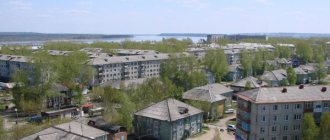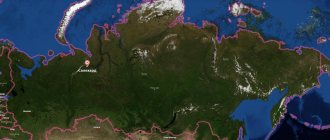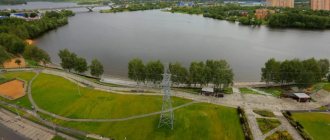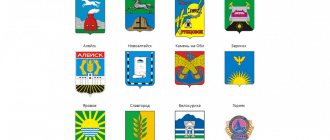Stavropol is located on a rolling plain in southwestern Russia. This is a major administrative one. The city is separated from Moscow by 1,450 km. An interesting feature of the city’s location, which can be noticed when viewing a map of Stavropol from a satellite, is that it is located at an equal distance from the Caspian and Black Seas. Also, a geographical feature of the city is its equal distance from both the equator and the North Pole.
On the western outskirts of the city there is one of the largest reservoirs in the region - Sengeleevskoye, which supplies the city with water. As the map of Stavropol with diagrams shows, the city has an elongated territorial shape from west to east. The city is surrounded by impressive forests to the south and west.
The area of Stavropol is about 170 m2, and if we take into account the boundaries of the urban district, it increases by another 100 km2. The rivers Gremuchka, Mamayka and Tashla flow through the city. There are no bodies of water in the city center - you can verify this by looking at the map of Stavropol by district.
For about 80 years, there has been an airport in Stavropol, which is located on the northeastern outskirts of the city. It receives and dispatches domestic and international flights daily.
Where is Stavropol?
Stavropol is the capital of the Stavropol Territory.
The city is located in the North Caucasus, on the valleys and hills of the central part of the Ciscaucasia, in the upper reaches of the Tashla River. Stavropol is also located at the highest point of the Ciscaucasia - on the watershed of the basins of two seas: the Caspian and Azov. From south to north, the territory of Stavropol extends for 16 km. The length of the city border is 165 km. The approximate population is 433 thousand people. The total area of Stavropol is 171 square kilometers. Nearest large cities: Maykop, Cherkessk, Essentuki. Stavropol is located in the southern part of the Russian Federation, which determines the climate of the territory. Most of the time the city is dominated by solar heat. The annual precipitation rate is 556 mm, the heights of points above sea level range from 230 to 660 meters.
Stavropol is located in the same time zone as Moscow, the offset relative to Coordinated Universal Time (UTC) is +3.
Economy and industry of Stavropol
Stavropol is a diversified industrial center. It has about 400 enterprises, the location of which can be seen on a detailed map of Stavropol. Most of the plants and factories are concentrated in the industrial area.
The city's economy consists of:
- Oil and gas enterprises;
- Chemical plants;
- Instrumentation;
- Pharmaceutical production;
- Light industry;
- Food factories.
Trade and the service sector make a large contribution to the city budget. As Yandex maps of Stavropol show, the city has many large shopping centers, restaurants, entertainment clubs, and beauty salons. Small enterprises are operating.
More than 35% of output comes from the city's food industry. The unemployment rate is very low. A large number of enterprises help retain young, qualified specialists in the city and grow their valuable personnel for industry and the economy.
Stavropoli Airport
There is an international airport in Stavropol, which has the status of a federal facility. The airfield is located in the suburbs. Airport type: jointly based. In addition to civil aircraft, the airport serves military aircraft.
Popular destinations for charter and regular flights: Moscow, St. Petersburg, Rostov-on-Don, Yerevan, Kaliningrad, Minsk, Dubai, Istanbul, Simferopol, Tel Aviv, Samui. The airport serves aircraft of major Russian airlines: UTair, Aeroflot, S7 Airlines, Azimut, Nordavia. The annual passenger traffic is 390 thousand people; annual cargo traffic is more than 1,200 tons.
Train Station
The passenger railway station is located at st. Vokzalnaya, 15. Stavropol railway station is a dead-end station in the Mineralovodsk region of the North Caucasus Railway. The railway station is located in the Oktyabrsky district of the city at st. Vokzalnaya, 17. The number of platforms is 2, the number of tracks is 7. The station building was built on January 1, 1897. In the railway station building there are several ticket offices for purchasing and returning tickets, a recreation area, a storage room, a buffet, and a medical center.
The most popular long-distance train destinations are Moscow and Adler. Suburban trains also run from the railway station to Kavkazskaya and Palagiada stations.
Bus stations Stavropoli
The central bus station of Stavropol is located in the city center at st. Marshala Zhukova, 27. The bus station building is located opposite the police clinic. The bus station's operating hours are from 4:30 to 23:00, without days off or long technical breaks.
Popular routes of regular buses: St. Petersburg, Adler, Anapa, Astrakhan, Budennovsk, Vladikavkaz, Volgograd, Grachevka, Grozny, Vysotskoye, Derbent, Donskoye, Yeisk, Zelenokumsk, Kizlyar, Krasnodar, Summer Headquarters, Neftekumsk, Prokhladny, Svetlograd, Sevastopol, Tbilisi, Sukhaya Buivola, Sotnikovskoye.
The most promising area in Stavropol for buying an apartment
Young families vote for a new district, which is called “Promising”. Krasnodar residents compare it with the Krasnodar young quarter “Panorama”, the only thing is that there is no stadium here. The area is built up with high tower buildings of the monolith-brick type, adjacent to which are adjacent infrastructure (children's playgrounds, parking, commercial areas). Nearby are kindergartens, schools, clinics, dentists. Residents of these high-rise buildings praise the apartments, the work of housing and communal services, and confirm that the place to live is comfortable.
Automobile highways
Federal highways pass through Stavropol:
- P216 “Kalmychka” is a federal highway. The route connects 3 large cities: Astrakhan, Stavropol and Elista. The road originates in Kochubeevsky. The final point of the route is Astrakhan. Road surface: asphalt.
- P217 "Caucasus" is a highway that has the status of an object of federal significance. The total length of the route is 1,118 km. It is part of two European routes: E50 and E119. The road starts at Pavlovskaya station and passes through Grozny, Makhachkala and Mineralnye Vody. The final point of the route is the border with Azerbaijan. Road surface of the federal highway: asphalt.
Popular message topics
- The works of Alexei Nikolaevich Tolstoy
Alexey Nikolaevich Tolstoy is a Soviet writer from the Tolstoy family. He was a winner of the Stalin Prize 3 times. The desire to write appeared in the young Tolstoy shortly before graduating from college. - History and inventions of steam engines
The very first steam engine was described by the Greek scientist Heron of Alexandria. The model was described as pneumatic. The design was a bronze cauldron with water inside. The boiler stood on supports, covered with a lid on top. Two are attached above the lid - History and research of Antarctica
The vast and southernmost region of the globe is called Antarctica. But Antarctica is Antarctica and the adjacent shelf zones. Antarctica is washed by three of the four oceans - the Atlantic, Indian and Pacific. Continent area
What is Stavropol famous for?
First of all, the city of Stavropol is known for being the Little Motherland of the first and last president of the USSR, Mikhail Gorbachev. In the local House of Culture you can find a portrait of the President of the Union. Also in this city was born the Secretary of the CPSU Central Committee Yuri Andropov.
Among the attractions, it is worth noting the monument to the Red Guard Soldier, which was erected on Fortress Hill in the 1970s. The monument was erected in honor of the liberation of Stavropol from the White Guards. In the central part of the city there is Alexander Square - the busiest square in the city. The square received its name in honor of Emperor Alexander II. In the center of Alexander Square there is a stele with a figure of a guardian angel.
War: Stavropol Territory 1941–1945
Galina Kameneva, May 7, 2022, 13:30 - REGNUM Stavropol Territory is a subject of the Russian Federation, part of the North Caucasus Federal District. By the beginning of the Great Patriotic War, the region was called Ordzhonikidze.
Departure of the 63rd Cavalry Division to guard the mountain passes of the Caucasus. September 1942
On March 13, 1937, after the death of Sergo Ordzhonikidze, to perpetuate the memory of the revolutionary, the North Caucasus region was renamed Ordzhonikidze. On February 22, 1938, five northern districts of the Dagestan Autonomous Soviet Socialist Republic (Achikulaksky, Karanogaysky, Kayasulinsky, Kizlyarsky, Shelkovsky) were transferred to the region. Of these, the Kizlyar Autonomous Okrug was formed with its center in the city of Kizlyar. Thus, the region included two autonomous regions (Karachay and Cherkessk), one district, 39 districts and eight cities of regional subordination. On January 12, 1943, the name of the region was returned - Stavropol.
The administrative center of the region is the city of Stavropol. From March 13, 1937 to January 12, 1943 it was called Voroshilovsk (in honor of the statesman K. Voroshilov), then the name of the city was returned - Stavropol.
Women dig trenches on the outskirts of Stavropol. Autumn 1941
Residents of the city of Voroshilovsk (Stavropol) at the construction of an anti-tank defensive ditch. December 1941
Population
According to the All-Union Population Census of 1939, 1,950,887 people lived in the Stavropol (Ordzhonikidze) Territory, and by the end of the war - on July 1, 1945 - the population, according to the State Archive of the Economy of the Russian Federation, amounted to 1,340,600 people. More than 320 thousand Stavropol residents were mobilized into the army and navy during the war years.
Army and partisan resistance
Dozens of military formations were formed on the territory of the Stavropol Territory. Among them: 5th Stavropol (later 1st Guards) Cavalry Division named after. Blinova, who fought her way to Prague; 53rd (later 4th Guards), which became part of the famous cavalry corps of L. Dovator, participating in the battles near Smolensk, Moscow, reaching Germany; 343rd (later 97th Guards) Rifle Division, which showed itself heroically in the battles near Rostov-on-Don, in the Battle of Stalingrad, in the battle of Kursk; 56th and 70th Cavalry Divisions; 320th Infantry Division, 68th and 76th Marine Rifle Brigades, 511th and 6th Volunteer Regiments, 29th Separate Mortar Brigade and other formations.
Tens of thousands of Stavropol residents fought in the ranks of the 37th, 9th, 44th armies, in the 4th and 5th Guards Corps, which fought in the North Caucasus, took part in decisive battles on the territory of our country and in other countries Europe.
The inscription on a sign with an order from the German command
Soviet machine gunners are fighting for the city of Pyatigorsk. 1943
47 partisan detachments were created on the territory of the region, more than 2 thousand people fought in their ranks. More than 1,000 Stavropol partisans were awarded government awards, 247 died. During the days of the Soviet offensive, the partisans liberated 70 settlements in the region.
Of more than 320 thousand Stavropol residents drafted into the army and navy, more than 170 thousand died, about 27 thousand people returned disabled.
Heroes of the Soviet Union
More than 220 thousand Stavropol residents were awarded orders and medals during the Great Patriotic War. 241 Stavropol residents (different categories: natives, conscripts, those who lived in the region, who accomplished a feat in the region) were awarded the title of Hero of the Soviet Union (including 130 natives, 26 conscripts in the region), and with Karachay-Cherkessia, part of the Stavropol Territory, a total of 254 people.
50 Stavropol residents (including the Karachay-Cherkess Republic) became full holders of the Order of Glory, of which 28 were natives, seven were called up in the region.
Economy
Dozens of enterprises in the region produced military products, including the Georgievsk reinforcement and tire repair plants, the Stavropol, Stavropol tannery, the Pyatigorsk engine repair plant, the Nevinnomyssk wool washing factory, the Stavropol clothing factory, the Kislovodsk boot felting factory, the Pyatigorsk and Essentuki industrial plants and others.
, destroyed by the Nazi invaders during the occupation. March 20, 1943
At the Upper Bazaar. Summer-autumn 1942. Stavropol
Ammunition, equipment, skis, clothing, and shoes were manufactured for the needs of the front. For example, in the city of Stavropol it produced 82-mm mortars and PPSh machine guns, and an engine repair plant in the city of Pyatigorsk produced aerial bombs, grenades and fuses for them. More than 115 thousand Stavropol residents participated in the construction of defensive fortifications.
Since the fall of 1941, the region's railway workers have been working in a tense rhythm, in the face of enemy air raids. In the summer of 1942 alone, more than 50 thousand wounded were transported along the region's railway network. A real feat of the population of Stavropol was the construction of a new railway line Kizlyar - Astrakhan with a length of 348 km, along which strategically valuable cargo flowed in a continuous flow. After the enemy occupied Rostov and Salsk, this highway was the only exit from the Caucasus to the railway network of the Soviet Union. From August to October 1942, 16 thousand tanks of fuel were sent along it to Stalingrad alone.
Evacuation
The evacuation of the population and property in the region, which took place in a hurry from July 27 to August 2, 1942, was carried out primarily from the 16 northern regions of the region. More than 40 thousand people were evacuated from the rural population, about 20 thousand people from the city of Stavropol (Voroshilovsk), and 60 thousand people from the cities of the Caucasian Mining Group (Pyatigorsk, Essentuki, Kislovodsk, Zheleznovodsk). In total, more than 100 thousand people, not counting those who chose themselves. In addition, up to 30 thousand wounded were evacuated from hospitals in the region.
The post office and telegraph building in the city of Stavropol, destroyed by the Nazi invaders during the occupation. 1943
1 million head of livestock, 8 million pounds of grain, 6,500 tons of wool, 1,100 tons of raw hides, 1,600 tractors, 600 combine engines, valuable enterprise equipment, non-ferrous metals, and cash reserves were exported. However, given the unexpectedness of the occupation of the North Caucasus as a whole, a significant part of the region’s material assets could not be removed.
Defense of the region
The battle for the Caucasus took place on the territory of the Stavropol Territory, which became one of the longest in the Great Patriotic War. It lasted for 442 days (from July 25, 1942 to October 9, 1943) and went down in the history of military art as a complex of defensive and offensive operations carried out over a vast territory in difficult conditions of steppe, mountainous and mountain-forested areas, in coastal areas . The battle took place simultaneously with the Battles of Stalingrad and Kursk, and played a big role in creating and completing a radical turning point during the Great Patriotic War.
By the beginning of the battle for the Caucasus, our army was inferior to the enemy in manpower by 1.5 times, in aircraft by eight times, in tanks by more than nine times, and in guns and mortars by two times. By January 1943, the Red Army managed to create an advantage in manpower and equipment in the zones of action of the Southern and Transcaucasian fronts.
During the battle for the Caucasus, about 281 thousand enemy soldiers and officers were destroyed, over 6 thousand were captured, 1.3 thousand tanks were destroyed and shot down, over 2 thousand aircraft (during the battle the largest air battle of the war took place ), 2127 guns, over 7 thousand guns and mortars, 22 thousand vehicles.
Soldiers of a mountain rifle squad during a combat mission
Military training classes for the population
Workers at classes under the general education program
The enemy's Operation Edelweiss failed; the Germans failed to capture the oil-bearing regions of our country. The Wehrmacht was unable to penetrate the Middle East, and Turkey never entered the war.
The victory came at a high price for the Soviet troops. Losses amounted to 344.3 thousand people, and sanitary losses - over 605 thousand people.
Hundreds of thousands of soldiers were awarded orders and medals. The medal “For the Defense of the Caucasus” (January 25, 1943) was awarded to many battle participants and home front workers (583,045 people in total). Five people performed feats on the territory of Stavropol during the Battle of the Caucasus and were awarded the title of Hero of the Soviet Union for their services during the Great Patriotic War: Aidamir Achmizov , Vladimir Gretsky , Pyotr Nikolaenko , Pyotr Rudenko , Vasily Uskov .
Labor contribution of Stavropol residents to the cause of Victory
Throughout the war, a wide network of hospitals operated in the region, mainly in the cities of Kislovodsk, Pyatigorsk, Essentuki, and Zheleznovodsk. By August 1941, about 50 hospitals with a capacity of 32 thousand beds were deployed in the Caucasian Mineral Waters alone.
Stavropol. January 1943
The Stavropol region, traditionally the country's food granary, during the war years provided the Motherland with 1.9 million tons of bread (in addition to the fact that 509 thousand tons of grown grain were exported by the occupiers), approximately 100-120 thousand tons of meat, 130 thousand tons of milk, 250 million eggs.
In the first year of war - in connection with the mobilization of men of military age into the army - the population of the region in all sectors of life assumed increased planned indicators. In production, there was a competition between brigades for the title of front-line brigades; in 1941 there were 220 of them. Productivity in agriculture was especially high, the region was among the best in the country. In the spring, tractor drivers of Stavropol became the initiators of the All-Union Socialist Competition of Women's Tractor Brigades, which contributed, in conditions of a shortage of labor and equipment, to the implementation of the field work plan.
During the period of occupation (August 2, 1942 - January 27, 1943), the region suffered enormous material damage - amounting to 14.6 billion rubles. All important cultural and economic objects, all means of communication and communications, more than 5 thousand buildings of industrial and production importance, and the entire hospital network were destroyed.
More than 32 thousand civilians were killed. In general, taking into account migration and mobilization processes, mortality, the population decreased by a third. The demographic indicators of the ratio of men and women in the region were among the most critical in the country: for every 100 men aged 16 to 55 years, there were 260 women.
Residents collect water in occupied Stavropol
In the spring of 1943, residents of the region carried out enormous work to restore 297 enterprises destroyed by the invaders, out of 341 enterprises that were operating before the arrival of the invaders. Defense enterprises were restored first. Thus, in the city of Stavropol, completely destroyed, already in 1944 it gave record indicators of labor productivity (250−480%), was noted by the Central Committee of the Komsomol and the People's Commissariat of Mortar Weapons, and was among the best enterprises of the Soviet Union in the competition of front-line production brigades.
The farms of all state and collective farms, 5 thousand livestock farms, 100 thousand square meters of housing and administrative buildings, 1416 schools, the entire system of higher and secondary specialized education, 119 hospitals, 295 outpatient facilities, 158 kindergartens, 170 cinemas and transport stations were recreated .
Charitable contribution of Stavropol residents
Substantial material assistance was provided by the residents of Stavopol to the Leningrad and Tula regions. More than 150 thousand evacuees (from Leningrad, Odessa, Zaporozhye and Kyiv regions of Ukraine) were accommodated in the region. The total number of evacuees, taking into account those temporarily accommodated in the region, is much greater. Thus, on October 1, 1941, 226 thousand people were registered who arrived from other territories and regions, some of whom were heading to Transcaucasia.
Red Army warrior feeding a child
The population of the region sent over 500 thousand parcels for the soldiers of the Red Army; in the first war winter alone, 579 thousand warm clothes (fur coats, burkas, felt boots, cotton trousers, earflaps) were sent to the soldiers at the front.
The donor movement in the region was active; only in the post-occupation period, the three largest blood transfusion stations (Pyatigorsk, Essentuki, Stavropol) sent more than 10 tons of blood to the Red Army soldiers.
Stavropol organizations donated more than 10 tons of fats, 17 tons of meat, 31 tons of bread products, 45 tons of fruits, 288 tons of vegetables to hospitals in Caucasian Mineralnye Vody.
Residents of the region contributed more than 500 million rubles from their personal savings to the National Defense Fund. These funds were used to build the tank columns “Stavropol Collective Farmer”, “Chekist of the Caucasus”, the armored train “Komsomolets of Stavropol”, and the flight of combat aircraft “Pioneer of Stavropol”.
Children's swings on cannons abandoned by German troops
Awards
On July 7, 1977, the city of Stavropol was awarded the Order of the October Revolution for the successes achieved in economic and cultural construction, including during the Great Patriotic War.
The city of Kislovodsk, which was a large hospital base and made a great contribution to the treatment of sick and wounded Red Army soldiers during the Great Patriotic War, was awarded the Order of the Patriotic War, 1st degree, in 1980.
In 2022, the municipalities “Achikulak Village Council” (Neftekumsky District) and “Bogdanovsky Village Council” (Stepnovsky District), where fierce battles took place during the Battle of the Caucasus, were given the honorary name “Frontier of Military Glory.”
Original War: Stavropol Territory 1941−1945 created 05/07/2020 at 13:33









